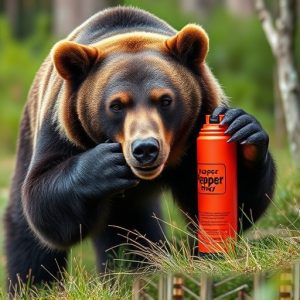Bear Spray vs Regular Pepper Spray: Range & Effectiveness Unveiled
Bear spray is a specialized self-defense tool designed to deter bears, unlike regular pepper spray t…….
Bear spray is a specialized self-defense tool designed to deter bears, unlike regular pepper spray tailored for human use. It utilizes capsaicin in higher concentrations and targets bears' sensitive nose and eyes within a 3-4 meter range, offering a crucial escape window (20-30 feet) against aggressive bears. While effective, weather conditions can impact its reach. Bear spray has proven more reliable than regular pepper spray in real-world bear encounters, reducing conflicts and serving as an essential safety measure for outdoor enthusiasts in bear country.
“Uncovering the Power of Bear Spray: A Comprehensive Guide explores its role as a unique deterrent against bears. This article delves into the science behind bear spray’s range and effectiveness, comparing it to regular pepper spray. We examine key differences and factors influencing its deterrent power. From real-world success stories to best practices, this guide provides insights into navigating bear encounters safely. Discover how understanding bear spray can enhance your outdoor experience, offering peace of mind in bear country, especially when considering Bear Spray Vs Regular Pepper Spray.”
- Understanding Bear Spray: A Unique Defense Mechanism
- The Science Behind Bear Spray's Range and Effectiveness
- Bear Spray vs Regular Pepper Spray: Key Differences
- Factors Influencing Bear Spray's Deterrent Range
- Real-World Applications: Success Stories and Best Practices
Understanding Bear Spray: A Unique Defense Mechanism
Bear spray, unlike regular pepper spray, is specifically designed to deter bears—a unique defense mechanism in the wild. While regular pepper spray targets the eyes and respiratory system, causing temporary blindness and coughing, bear spray is formulated with capsaicin, a chemical that irritates a bear’s sensitive nose and eyes, creating a powerful deterrent. This specialized spray has a distinct range, typically between 3 to 4 meters (10-13 feet), offering users a crucial window of safety during encounters in bear country.
Unlike regular pepper spray, which is effective against humans and other animals, bear spray targets the animal’s natural defenses. Bears have an excellent sense of smell, making them highly susceptible to capsaicin. When sprayed, the strong odor creates discomfort, causing bears to retreat or avoid potential threats. This makes bear spray a game-changer for outdoor enthusiasts navigating areas with bear populations, providing an effective and non-lethal means of protection.
The Science Behind Bear Spray's Range and Effectiveness
The effectiveness of bear spray is rooted in its unique composition and application method, which sets it apart from regular pepper spray. Unlike standard pepper spray that relies on capsaicin to induce a burning sensation and temporary blindness, bear spray incorporates a potent mixture of capsaicin and other active ingredients designed to deter aggressive bears. This blend not only causes discomfort but also disrupts the animal’s sense of smell and vision.
When used properly, bear spray can be effective up to 20-30 feet (6-9 meters), providing users with a crucial window of opportunity to retreat or defend themselves. The range offers a strategic advantage compared to regular pepper spray, which typically has a shorter effective distance. This distinction is vital in bear country, where encounters can occur at close ranges, making bear spray a game-changer for outdoor enthusiasts and individuals living in bear habitats. Moreover, bear spray vs. regular pepper spray, the former offers enhanced protection against larger, more aggressive bears due to its specialized formula.
Bear Spray vs Regular Pepper Spray: Key Differences
When it comes to self-defense against bears, understanding the differences between bear spray and regular pepper spray is crucial. While both are designed to deter and disable an attacker, they operate on distinct principles and have varied effectiveness. Bear spray, specifically formulated for use against large wildlife like bears, uses capsaicin oil in a much higher concentration than regular pepper spray. This potent formula can effectively reach and irritate a bear’s eyes, nose, and mouth, creating enough disorientation to allow an individual to escape.
Regular pepper spray, on the other hand, is more commonly used for human-to-human interactions or against smaller predators. It still employs capsaicin, but in a lower concentration tailored for human sensitivity. Bear spray’s key advantage lies in its specialized design, ensuring it will project far enough to reach bears at close range, a typical scenario during encounters in wilderness areas. This specialization makes bear spray a more reliable deterrent when facing larger, more powerful wildlife.
Factors Influencing Bear Spray's Deterrent Range
The effectiveness of bear spray as a deterrent is influenced by several key factors. One major distinction from regular pepper spray is the target species – bear spray is specifically designed to deter bears, which have thick fur and may not be affected by regular pepper spray. Additionally, bear spray typically contains a higher concentration of capsaicin, the active ingredient responsible for the burning sensation, allowing it to penetrate bear senses more effectively.
Another crucial factor is the distance at which the spray is used. Bear spray is most effective when deployed from close range, usually within 20-30 feet (6-9 meters), as bears can quickly lose sensitivity to the spray if sprayed from farther away. Weather conditions also play a role; wind, temperature, and humidity can affect the spray’s reach and intensity, making it less reliable in certain environments.
Real-World Applications: Success Stories and Best Practices
In real-world scenarios, bear spray has proven to be an effective deterrent against aggressive bears, offering a significant advantage over regular pepper spray. When used appropriately, it can create a protective barrier, providing users with crucial time to retreat or seek safety. Success stories abound of hikers and campers who, armed with bear spray, have successfully avoided dangerous encounters.
Best practices for using bear spray include understanding the recommended range—typically around 20-30 feet (6-9 meters)—and ensuring proper application techniques. Unlike regular pepper spray which can be affected by wind or angle, bear spray is designed to create a cloud of irritants that directly target an animal’s eyes and respiratory system. This strategic use has been instrumental in reducing bear-human conflicts, making it a must-have for outdoor enthusiasts navigating bear country.
Bear spray has established itself as a highly effective deterrent against bears, offering a unique defense mechanism compared to regular pepper spray. Understanding its range and science is key to ensuring its successful application in real-world scenarios. The article highlights the distinct differences between bear spray and regular pepper spray, while also factoring in influences that can impact the deterrent range. By examining success stories and best practices, we gain valuable insights into navigating encounters with these majestic creatures, ultimately enhancing our safety and appreciation for their natural habitats.


